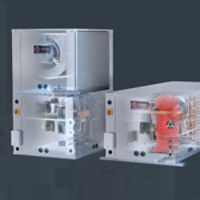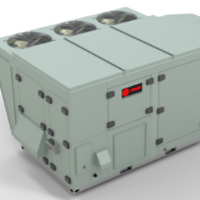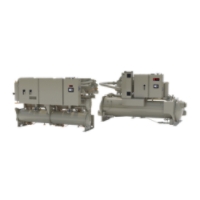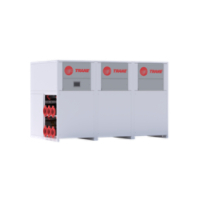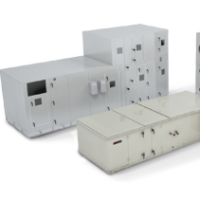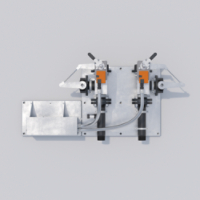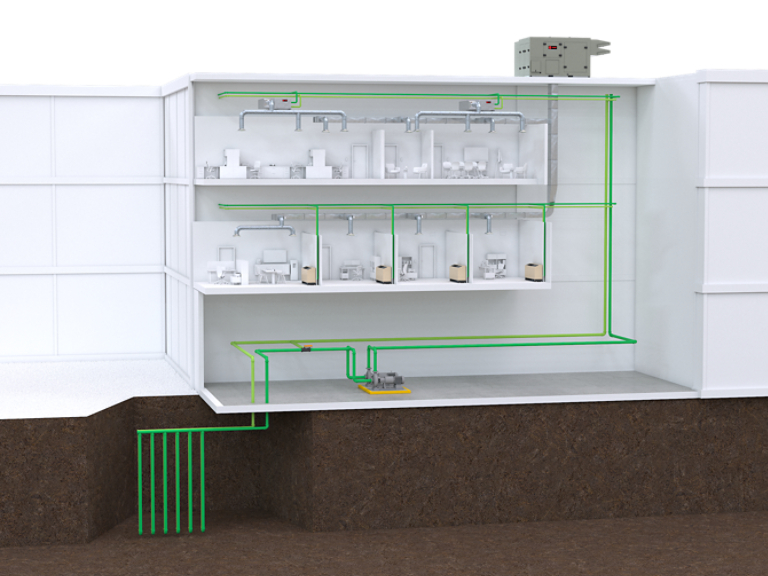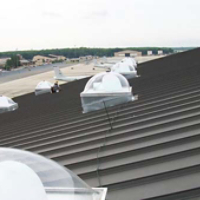A dedicated outdoor air system (DOAS), multiple water-source heat pumps, and a ground-source heat exchanger work together to use the ground as a stable heat source, harnessing the earth's constant temperatures for highly efficient, year-round operation.
Geothermal Heat Pump Systems
Distributed and Centralized Geothermal Systems
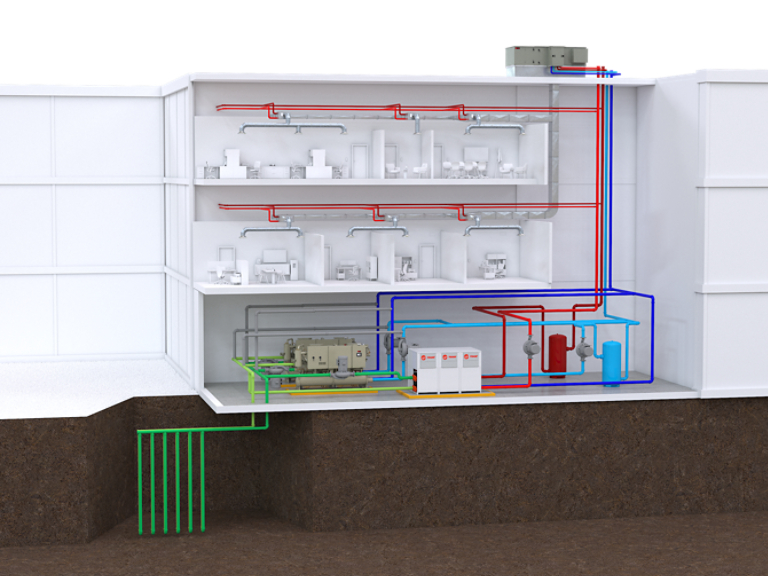
Overview
Geothermal heat pump system advantages.
Harnessing the earth’s stable and moderate temperatures for heating and cooling using heat pumps helps provide highly efficient, year-round operation.
-
Highly Efficient
Because the earth’s temperature is more moderate than the outdoor air temperature, geothermal heat pump systems can improve the annual energy efficiency of heat pump systems up to 50%.
-
Environmentally Friendly
Geothermal systems use renewable energy storage from the earth. Tapping into this natural resource helps reduce electric utility demand, emissions and improves resiliency.
-
Economically Effective
Geothermal heat pumps combine heat recovery with use of the earth as a natural heat sink and source, which helps reduces life-cycle operating costs compared to conventional cooling and heating systems.
Product Information
-
Trane Axiom water source heat pumps deliver superior energy efficiency, reliable performance, and flexible installation options for commercial buildings.
-
Horizon® Dedicated Outdoor Air Systems (DOAS Unit)
Horizon DOAS units are designed specifically to condition 100% outside air year-round, reduce latent loads, enhance the entire building system’s comfort and energy efficiency, and maintain your building’s health. It eliminates excess moisture, preventing discomfort and the health risks associated with mold and microbial growth.
Heat pump chillers paired with a variety of airside systems, including variable air volume (VAV) and air handlers, working with a ground source heat exchanger to use the ground as a stable heat source, harnessing the earth's constant temperatures to provide highly efficient, year-round operation.
-
Series R™ Helical Rotary Screw Chillers
Proven performance, modern versatility: Series R™ helical rotary screw chillers deliver precise, reliable thermal management with low-GWP refrigerants in a compact, easy-to-install design for a wide range of applications. -
Thermafit™ Modular Water-Source Multi-Pipe
Thermafit™ Modular Water-Source Multi-Pipe: Simultaneous heating/cooling, 30-60 ton capacity, modular design for flexibility and efficiency. -
VariTrane® Variable-Air-Volume Units
Enhance your airflow management with VariTrane® VAV units: rugged variable-air-volume units available in different profiles with digital controls for energy-efficiency. -
Performance Climate Changer® Air Handlers
Trane® Performance Climate Changer® air handlers can help HVAC systems improve efficiency and indoor air quality while reducing maintenance requirements. -
The Hydronic Branch Conductor enables sustainable, effective heating and cooling that can improve comfort and reduce installation and energy costs in hydronic heat pump systems.
| Characteristics of Heat Pump Systems | Distributed System | Central System |
| Number of heat pumps | Multiple (one per zone) | Few |
| Heat pump technology | Water-to-air heat pumps | Hydronic water-to-water heat pump chillers |
| Location of heat pumps | In or near occupied space | Mechanical equipment room |
| Method of distributing air to space | Each heat pump delivers air to zone | Airside flexible including centralized air handlers with VAV boxes |
| Efficiency | High, but lower than central systems; good zone control | Very high using high efficiency compressor and airside equipment |
| Maintenance | More heat pumps to maintain, but offers redundancy (if one unit fails, others can still operate) | Centralized maintenance, but single point of failure can impact whole building |
| Acoustics | Some sound in occupied space due to compressors in zone | Compressors & fans located away from space provides quieter occupant spaces |
| Humidity control | Generally a constant volume system requiring a dedicated outdoor air system | Better centralized humidity control using VAV systems |
| Ventilation | Requires separate dedicated outdoor air system | Allows outdoor air to be treated and distributed along with mixed air |
Trane Design Assist: We’re making it easy to support your heat pump designs with a free, web-based self-service tool providing comprehensive documentation like overall project layouts, flow diagrams, sequence of operations, points list, and project guide specifications.
Trane TRACE: For over five decades, TRACE™ has been at the forefront of building design and analysis, setting the standard for excellence and innovation. Our legendary software program has empowered countless professionals to design with ease and innovate with confidence.
FAQs
Your questions about geothermal heat pump systems, answered.
A geothermal heat pump is HVAC equipment that can heat or cool a building by tapping into the earth, utilizing a stable source of renewable energy such as the ground or a lake.
Geothermal or “ground-source” heat pumps heat or cool a building by coupling to the earth in several ways. These are sometimes referred to as “ground-coupled systems.” They transfer energy to borefields using a closed loop heat exchanger installed in vertical bore holes or in horizontal trenches.
The ground source heat pump can use the ground as a “thermal battery,” storing energy into the ground when the building is cooling (energy charge) and extracting energy from the ground to provide heat to a building (energy discharge).
The geothermal heat pump transfers energy from the ground or lake to heat or cool a building. Additionally, the geothermal heat pump may also recover excess heat from within the building eg. people, computers, lighting. That heat is then transferred to other parts of the building or into the ground or lake for later use.
A central geothermal system consists of one or more chillers or heat pump chillers centrally located in a single mechanical room, coupled with a geothermal loop. The chiller/heaters provide heated and cooled fluid to hydronic heating and cooling air handlers throughout the building.
Ground source geothermal uses the ground as a form of energy storage. Energy is stored in the ground when the building is cooling (energy charge). Energy is extracted from the ground to provide heat to a building (energy discharge).
Ground source geothermal couples heat pumps to the earth utilizing borefields. The borefields refer to a closed loop heat exchanger installed in vertical bore holes or in horizontal trenches. Heat pumps inside the building transfer energy from borefields to the spaces that need heating and cooling.
Both distributed and central geothermal systems offer unique benefits beyond their geothermal function. As with any system, what one person views as an advantage, another person may view as a disadvantage.
Distributed systems use multiple small geothermal heat pumps located throughout a building, allowing for individualized zone control and built-in redundancy. However, they require maintenance at many locations and can generate more noise in occupied spaces due to nearby compressors.
The Central Geothermal System combines the energy efficiency of a traditional geothermal heat-pump system with the benefits of centralized heating, cooling and air handling to provide an even more efficient and comfortable geothermal system. Significant benefits include centralized maintenance, reduced noise, improved air cleaning and greater flexibility in equipment selection within the system.
One of the most critical elements in the design is the selection and layout of the ground heat exchanger. For example, the choice between horizontal and vertical heat exchangers is driven by available land, project budget, and capacity requirements.
Another major consideration is the configuration and control strategy of the heat pump equipment. Designers must decide between distributed systems and central systems. Each of these systems provides distinct benefits and drawbacks.
Lastly, system designers must evaluate maintenance of long-term ground temperatures and manage energy balance to the borefield to avoid situations of the borefield getting too warm or cold.
Looking for parts?
Resources & Insights
Explore the latest geothermal heat pump system resources.
-

Hospital Cite de la Sante Laval
Hopital Cité de la Santé, Laval, installed a Trane system, reducing energy costs and emissions. The system ensures optimal performance and comfort, supporting LEED certification. -
-
Robins Air Force Base is the home of Warner Robins Air Logistics Complex, the 78th Air Base Wing, and more than sixty other units that make up a vital part of the Air Force war-fighting team. It is the largest industrial complex in Georgia, employing a workforce of more than 24,000 civilians, contractors and military members.
-
Geothermal and Thermal Energy Storage Systems: Opportunities to Decarbonize
This webinar will explore trend shifts in the market to incentivize geothermal and thermal energy storage. Presenters will discuss key application considerations for distributed and centralized geothermal systems including a review of equipment. Thermal energy storage economics and cooling and heating system applications will also be discussed.

